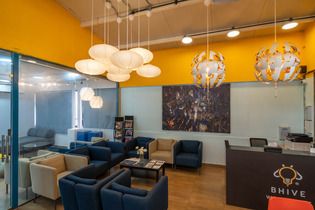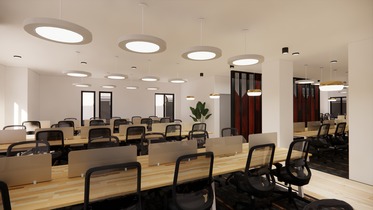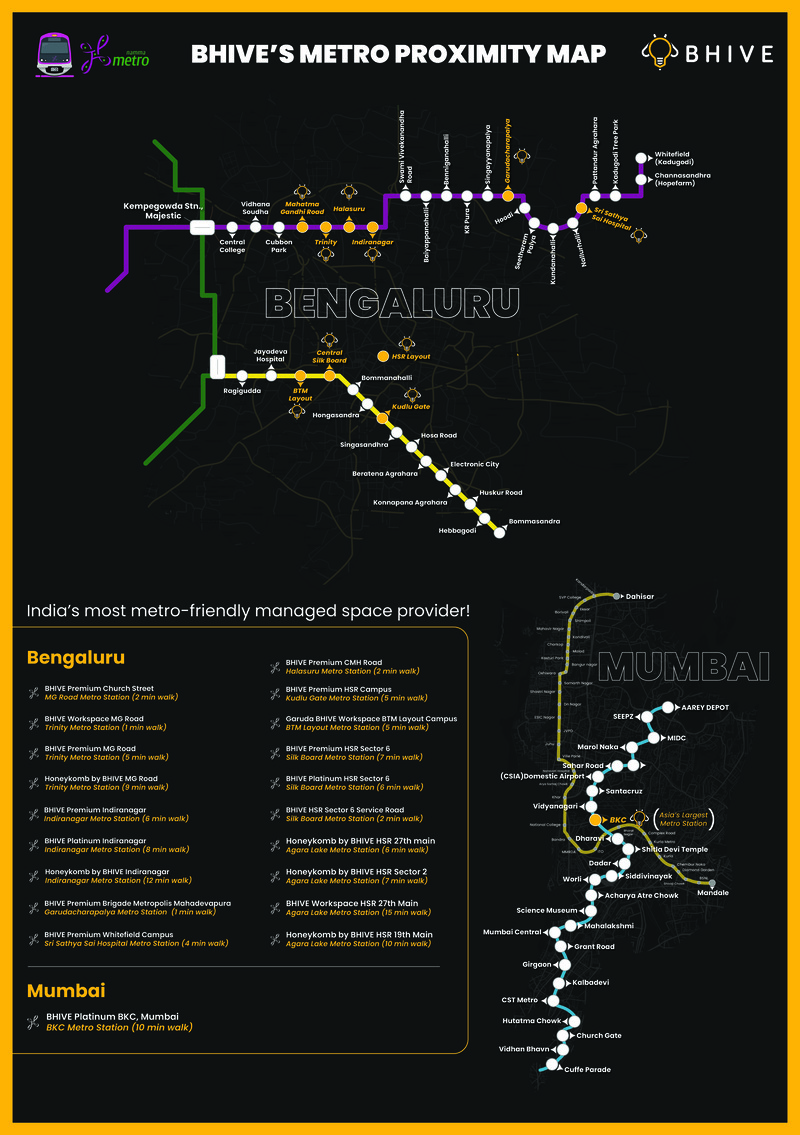Choosing an office space in 2024!

Choosing an office space in 2024. What are the factors to consider?
Table of Contents
- Current Trends in Office Space Utilization
- Factors to consider while choosing an office in 2024
- Location
- Space Design and Layout
- Technology Infrastructure
- Cost Considerations
- Company Culture and Brand Image
- Future Growth and Scalability
- Regulatory Compliance and Legal Considerations
- Environmental Sustainability
As the company landscape evolves in 2024, choosing an office space is critical for organizations looking to prosper. According to a recent poll, employees who are happy with their work settings are 16% more productive, 18% more inclined to stay, and 30% more likely to choose their firm over competitors. The modern era of hybrid models, remote work, and changing objectives means selecting managed office spaces is more important than ever. This article delves into the critical variables to consider while navigating the complicated landscape of office space choices in 2024, directing organizations toward facilities that promote productivity, creativity, and employee well-being.
2024 Trends in Office Space Utilization
In 2024, managed office space usage patterns show a dynamic transition toward flexible hours and agile settings. With the increased acceptance of hybrid work arrangements, workplaces are no longer only places for daily commutes but also cooperation, innovation, and culture creation. Companies prioritize flexible designs that cater to various workstyles, incorporating collaboration zones, silent places, and hot desks to meet changing team dynamics.
Innovative office solutions optimize space consumption and improve remote and in-office personnel connection. Furthermore, conservation efforts are gaining popularity, resulting in the incorporation of environmentally friendly elements and wellness-focused designs. In response to these shifts, organizations are rethinking traditional office spaces as flexible, inclusive, and future-proof settings that empower people and promote corporate success.
Factors to consider while choosing an office in 2024
Before delving into the considerations, it’s essential to understand that selecting the best office space in 2024 involves more than simply physical location or square footage. It is about building an atmosphere that promotes staff productivity, cooperation, and wellness in a fast-changing context. Businesses may successfully traverse the challenges of choosing managed office space by considering various crucial elements. Here are the main points to bear in mind:
Location
- Closeness to Target Audience: Consider the ease of access the office space offers your target audience or clientele. A comfortable location may improve customer connections and accessibility.
- Accessibility and Transport Options: Evaluate commuting convenience for staff and clients. Proximity to public transit hubs and significant roadways can increase accessibility and shorten travel times.
- Nearby Amenities & Facilities: Look for office premises near amenities like restaurants, cafés, gyms, and parks. Access to these amenities can improve employee happiness and well-being, resulting in a more favorable work environment.
Space Design and Layout
- Flexibility for Hybrid Work Models: Design an office layout allowing in-person and remote work arrangements. Flexible workplaces, hot desks, and collaborative rooms accommodate a variety of working styles and preferences.
- Integration of Collaborative Spaces: Design the office arrangement to promote cooperation and teamwork. Dedicated meeting rooms, breakaway sections, and open-plan layouts can help staff communicate and share ideas more effectively.
- Ergonomic Design for Employee Well-being: Prioritize ergonomic furnishings and workspaces that enhance worker comfort and output. Adjustable desks, ergonomic seats, and natural lighting may all help to create a healthier and more comfortable work environment, lowering the risk of injury and weariness.
Technology Infrastructure
- High-speed Internet and access: Ensure the workplace has dependable high-speed Internet access to facilitate seamless interaction and efficient work. Consider how the internet infrastructure may be scaled to support future development.
- Integration of Smart Office Technology: Use digital collaboration tools, automation systems, and Internet of Things (IoT) devices as part of your intelligent office setup to increase productivity and efficiency. These technologies can simplify processes, increase communication, and maximize resource usage.
- Data Security Measures: Implement robust cybersecurity procedures to secure sensitive data and prevent cyber attacks. This comprises encryption mechanisms, access restrictions, firewalls, and frequent security audits to verify industry standards and legislation adherence.
Cost Considerations
- Rent and Lease Terms: Determine the cost of renting or leasing managed office space, including the monthly rent, lease period, and other fees or taxes. Negotiate favorable conditions that are consistent with your budget and financial objectives.
- Maintenance and Utility Expenses: Include continuous maintenance expenditures, utilities (power, water, heating/cooling), and other office-related operating expenses. Budget carefully to minimize unforeseen financial constraints.
- Hidden Cost Identification and Budget Allocation: Examine carefully all possible hidden expenses, including property taxes, insurance rates, and maintenance charges. Set a realistic budget, including fixed and variable spending, to provide long-term financial stability and flexibility.
Company Culture and Brand Image
- Alignment with Corporate Values and Culture: Select an office space representing and supporting your organization’s values, goals, and culture. Consider the layout, design, and mood to guarantee consistency with your organization’s brand and ethos.
- Space Design Reflects Brand Identity: Design the workplace environment to represent your brand’s branding and personality. Incorporate branding components, colors, and visual signals that speak to your target demographic and support your brand image.
- Effect on Engagement and Productivity: Consider how the workplace culture affects engagement, morale, and output. A collaborative, creative, and well-being-focused environment may improve employee happiness and performance, eventually contributing to your organization’s success.
Future Growth and Scalability
- Capability for Expansion or Downsizing: Select an easily scalable office space to support your organization’s future expansion or contraction. Consider elements like the available squeezability of the plan and the lease terms that enable easy modifications to the space needed.
- Flexibility in Lease Terms: Negotiate leasing arrangements that provide flexibility and agility in meeting changing company demands. Look for short-term leases, growth provisions, or subleasing agreements allowing flexible scaling without long-term obligations.
- Customization or Reconfiguration Potential: Choose an office space that can be customized or reconfigured to meet changing business needs. This might feature modular furniture, demountable barriers, or adjustable layouts that can be readily changed to accommodate varied work styles, team configurations, or development paths.
Regulatory Compliance and Legal Considerations
- Building and Zoning rules: Verify that the workplace space conforms with the area’s applicable building and zoning rules. Check zoning classifications, occupancy limitations, and approved land uses to prevent legal problems or fines.
- Health and Safety Standards: Prioritize employee health and safety by choosing an office location that meets or exceeds all necessary health and safety regulations. This covers ventilation systems, fire safety precautions, accessibility features, and OSHA compliance.
- Lease Agreement and Contractual Obligation Review: Examine contract duties and lease agreements in detail to learn about your rights and obligations as a renter. Pay close attention to rent payment conditions, lease duration, maintenance obligations, renewal choices, and departure clauses to guarantee transparency and reduce potential dangers.
Environmental Sustainability
- Energy-efficient appliances, Smart Thermostats, and LED Lighting are some elements that may be included in an office space to cut down on energy usage and running expenses.
- Waste-Management and Recycling Initiatives: Implement recycling and trash management programs to reduce your effect on the environment and advance sustainability. To limit trash output, provide recycling bins and composting facilities and urge personnel to adopt sustainable habits.
- Pursuit of Green Certification and Incentives: Consider office facilities that have earned green certifications and conform to strict environmental criteria. Investigate the incentives and tax breaks available for environmentally friendly buildings to optimize cost savings and environmental advantages.
Conclusion
In the ever-changing environment of office space selection, thorough consideration of issues such as location, design, technology, pricing, culture, scalability, legal compliance, and sustainability is critical. Prioritizing these factors allows firms to develop settings that promote efficiency, cooperation, and employee well-being while adhering to company values and future growth objectives. Finally, selecting the best office space in 2024 is more than simply a physical location; it’s about establishing environments that encourage creativity and drive success in an ever-changing world.
Take a look at the workplace of the future with BHIVE-managed office spaces. Expand your business with adaptable, fully-equipped workplaces that promote productivity and cooperation. Book your tour now and see how BHIVE may help your team succeed in the contemporary workplace.








